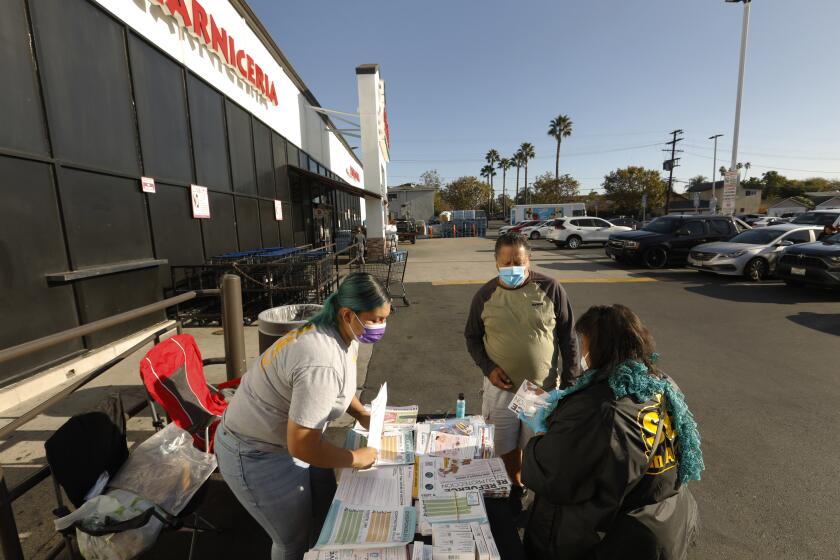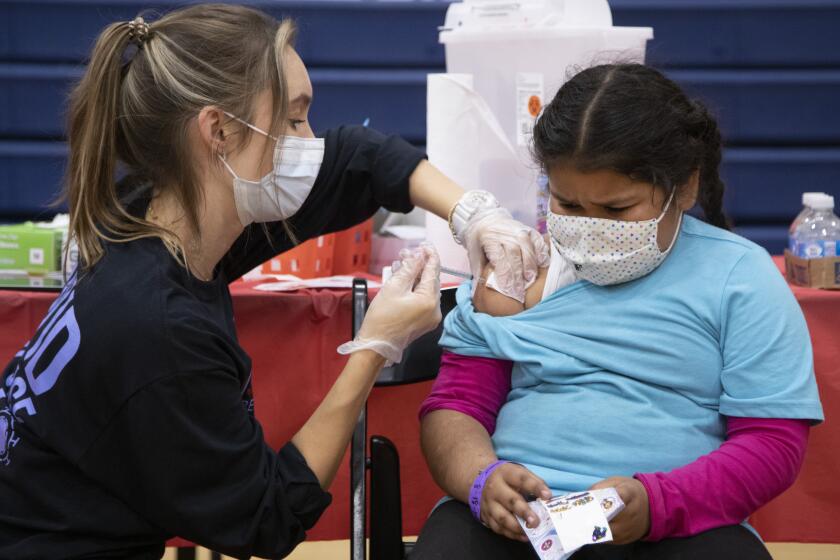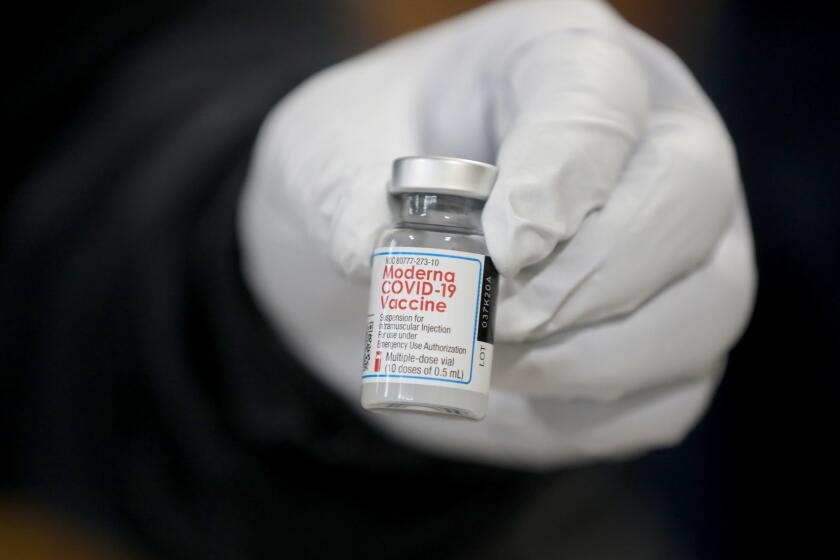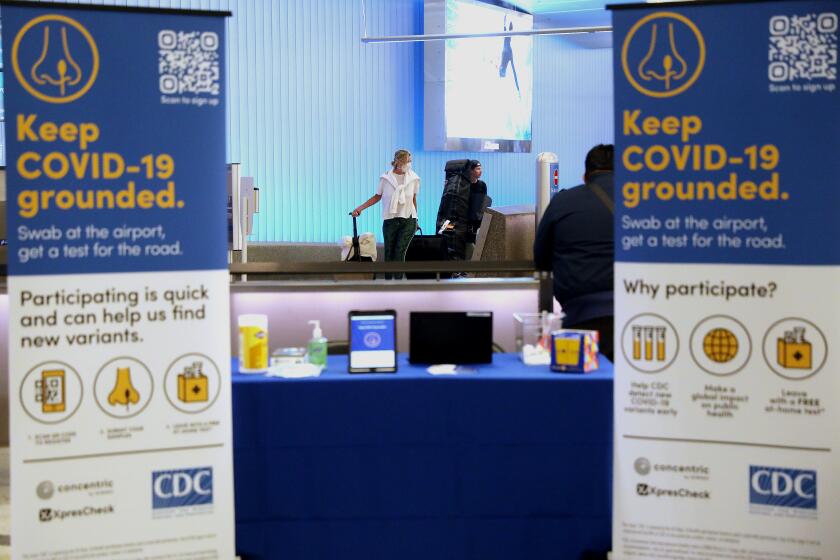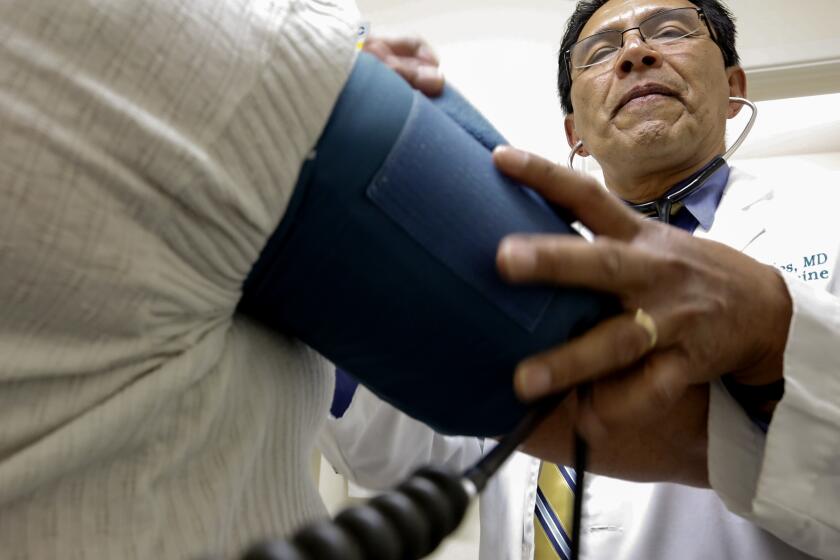L.A. County ends COVID-19 vaccine mandate for deputies, firefighters, employees

Los Angeles County has ended its COVID-19 employee vaccination requirement, allowing workers — including sheriff’s deputies and firefighters — to be hired even if they haven’t gotten a shot.
The policy change, which took effect Monday, is the latest COVID-19-related rule to be relaxed in L.A. County as officials continue to steadily unwind the emergency phase of their pandemic response.
“There is no longer a COVID-19 vaccination requirement for new hires or existing county employees, unless otherwise mandated by federal, state or local regulations or orders,” said Jesus Ruiz, a spokesperson with L.A. County’s chief executive office.
According to a statement issued on behalf of L.A. County officials, the end of the employee vaccination requirement is “in line with decisions to end the state of emergency by the Board of Supervisors.” The board voted unanimously to rescind that emergency declaration in late February, and the move became official a week ago.
The Board of Supervisors on Tuesday also approved the repeal of a rule requiring certain contractors for the county to be vaccinated against COVID-19 or to have received a medical or religious exemption.
The county public health chief says emergency orders are no longer needed ‘to ensure we have and can use life-saving tools and mitigation strategies.’
The end of the broader employee vaccine requirement doesn’t mean the end of all such mandates, however. Most healthcare workers still need to be vaccinated against COVID-19 due to federal rules covering facilities that accept money from Medicare and Medicaid.
L.A. County also still requires healthcare workers to complete their primary vaccine series and get at least one booster dose, or else receive an exemption from their facilities. That policy will be reassessed by September, but in the meantime, “new healthcare employees will need to comply with the existing vaccination requirements,” county Public Health Director Barbara Ferrer said.
The county’s COVID-19 vaccination mandate became effective Oct. 1, 2021, more than five months after the shots were made available to all adults in California.
The decision carried broad impact in L.A. County, the most populous in the nation. With more than 100,000 workers on the payroll, it’s Southern California’s largest employer, according to the county Department of Human Resources.
L.A. County elected and health officials said the vaccination mandate was appropriate when it was issued. At that time, Supervisor Janice Hahn said COVID-19 was the top killer of law enforcement officers nationwide.
California’s student COVID-19 vaccine mandate — on hold since last April — has been quietly dropped as the state prepares to end emergency pandemic restrictions.
A vaccine mandate for county workers protected not only employees but the public they served, officials said. Sheriff’s deputies and firefighters, for example, regularly come into contact with vulnerable or elderly people who would be subject to extraordinary risk of severe illness if infected.
“If you’re in the business of supporting the most vulnerable people in the county, then it makes sense for people to be fully vaccinated, especially during a pandemic,” Ferrer said in early 2022, as L.A. County was emerging from the deadly winter Omicron surge.
Data from that era of the pandemic showed that unvaccinated people had a higher risk of infection, hospitalization and death than those who had been vaccinated.
However, the requirement was controversial, sparking blowback and warnings it could trigger an employee exodus. Among the critics was then-Sheriff Alex Villanueva, who said in October 2021 that though he personally was vaccinated and believed the vaccine works, the decision should be a personal one. Villanueva also contended at the time that it made little sense to impose a vaccination requirement “with the pandemic waning.”
The city of L.A.’s Personnel Department sent a memo to department heads ordering them to approve all religious and medical exemptions to the COVID-19 vaccine mandate.
In fact, the requirement took effect just weeks before the emergence of the Omicron variant — which sent case counts skyrocketing, swamped hospitals and triggered a surge of deaths exceeded only by the pandemic’s first devastating winter.
L.A. County employees could seek exemptions from the vaccination requirement if they had either a medical reason or a “sincerely held religious belief, practice, or observance that conflicts with an individual’s ability to receive a COVID-19 vaccine.”
Out of a countywide workforce of more than 100,000 employees, 7,359 vaccine exemption requests were approved. Sixty-eight workers were separated from county employment for noncompliance with the vaccination policy, officials said.
At the time the employee vaccination mandate took effect, 68% of L.A. County residents 6 months and older had received at least one dose of vaccine. According to the most recent data, 81% of residents in that same age range have done so. It’s unclear to what extent the vaccine mandate may have contributed to boosting inoculation rates.
Transitioning out of the COVID emergency phase could eventually spell the end of universal access to free vaccines, treatments and tests.
Much has changed since the original employee mandate was issued, including the introduction of an updated booster shot designed against the sprawling family of Omicron subvariants, plentiful supplies of therapeutic anti-COVID-19 drugs and broader immunity through vaccinations and infection. The evolution of the coronavirus also has been more stable in the last year, meaning many tools that were effective months ago remain so today.
While the shots’ efficacy against infection has waned, officials note they continue to provide strong protection against the worst health outcomes.
This January, unvaccinated Californians were 2.6 times more likely to get and be hospitalized with COVID-19 and 2.9 times more likely to die from the disease than those who had received at least their primary vaccine series, according to data from the California Department of Public Health.
More recently, Ferrer said L.A. County has entered a new pandemic phase, in which hospitals are no longer threatened with being overwhelmed by COVID-19 patients.
“The place we’re in right now is unique because transmission is relatively low, and hospitalizations are even lower,” she said.
California will soon require Medi-Cal recipients to prove their eligibility again. But it has a safety net for people who lose their coverage.
Ferrer added that the COVID-19 vaccines are still important.
“We’ve had two years where the vaccines have been shown to be effective. And we don’t really have serious side effects that are experienced by almost everyone who gets vaccinated,” she said.
For the most recent yearly period, between April 2022 and March 2023, about 145,000 U.S. residents died from COVID-19, according to the U.S. Centers for Disease Control and Prevention.
By comparison, 547,000 COVID-19 deaths were reported between April 2020 and March 2021 and about 423,000 deaths from April 2021 through March 2022.
The U.S. COVID-19 death toll of 1.1 million is greater than that of the last severe global pandemic of its kind, the flu pandemic that began in 1918. That pandemic caused an estimated 675,000 deaths nationally.
More to Read
Sign up for Essential California
The most important California stories and recommendations in your inbox every morning.
You may occasionally receive promotional content from the Los Angeles Times.
